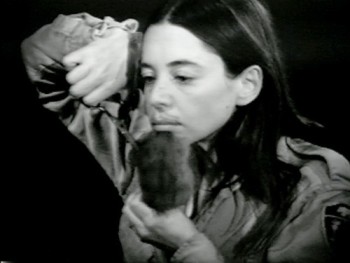History in her own words: Eleanor Antin’s Conversations with Stalin
Without much exaggeration Eleanor Antin could be called the King of conceptual and performance art. Working mainly in film, video, and performance Antin is often cited as one of the first artists to reintroduce autobiography, confession and performance to the art world during the 60’s and 70’s. In 1972 Antin created her male alter-ego with the photographic and video series “The King of Solana Beach,” in which an apprehensive king is shown reconstructing his own past by collecting pieces of his broken kingdom. Her video “The King” (1972) stands as a journal entry of the King’s evolving identity as well as showing Antin’s striking transformation from her male persona to own herself, and is on view in the exhibition Elles: Women Artists from the Centre Pompidou, Paris.
For Antin art is not necessarily an object or something that can be historically defined, but something close to her own individuality, or a memoir of history retold in her own words.
Early on in her career Antin made her name as a conceptual artist by creating works that successfully diverted traditional means of art making and artist representation. For instance her work 100 Boots (1971) used the US Postal Service to distribute photographs of 100 boots Antin had placed in various Southern California locations. The scenes were printed onto postcards and sent to artists, writers, dancers, art institutions and libraries at 3 to 5 week time intervals to create a puzzling visual narrative. The boots became travelers and characters in a two and a half year journey that finally culminated in a solo exhibition at the Modern Museum of Art in New York in May of 1973.
Her recent photographic series attempts to re-enact and modernize historical narratives by placing them under the context of contemporary American life.Helen’s Odyssey (2007), inspired by the Greek legend Helen of Troy, recasts Helen as two individual roles to exemplify polar sides of her personality. Antin shows both Helens in various scenes reacting differently to scenarios based on the Greek myths of Homer, who the beautiful and vengeful Helen eventually murders. History is here recast to portray the two Helen’s as contemporary versions of their ancient characters carrying large totes and wearing thick rimmed sunglasses.
Her recent memoir, titled Conversations with Stalin: Confessions of a Red Diaper Baby (2010), is a black comedy detailing Antin’s life growing up in New York in a family of first generation Jewish, communist immigrants in the age of Stalin. Join Antin for a performative reading of her new book this Saturday at Seattle Art Museum.
Seattle Art Museum
“Conversations with Stalin” by Eleanor Antin
December 1, 2012
2-3 pm
Nordstrom Lecture Hall
Ryan Peterson, Program Assistant
Eleanor Antin, “The King,” 1972. Video (black and white, silent), TRT: 52 min. Courtesy of Electronic Arts Intermix (EAI), New York.

